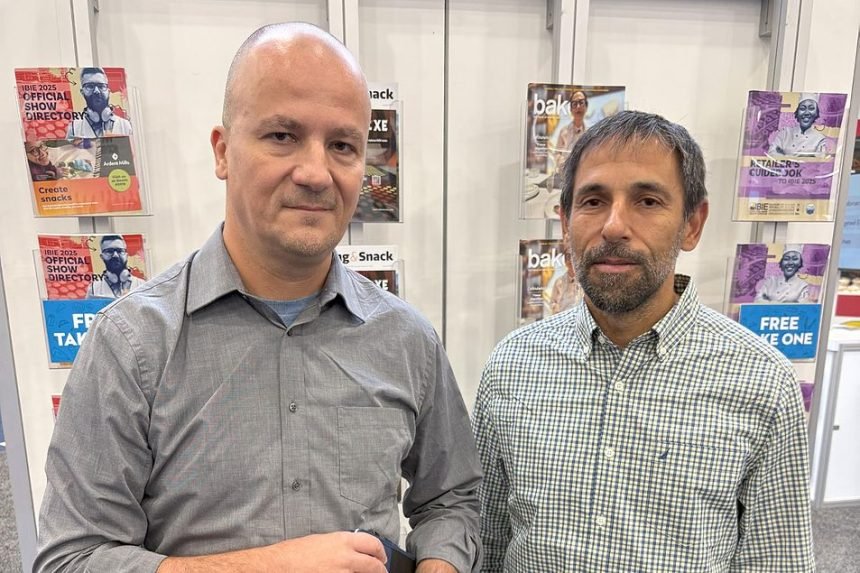LAS VEGAS — A step forward in assessing the prospective baking qualities of a given lot of wheat is on the cusp of realization due to new technologies using real-time biochemical measurements and artificial intelligence, according to the founder of an agri-food-tech startup company.
In an interview conducted at IBIE 2025 in Las Vegas, Gil Shalev, co-founder and chief executive officer of Equinom Ltd., said data from existing Near-Infrared (NIR) Spectroscopy equipment will offer insights into baking qualities such as the rheological properties of dough or standard baking performance measures such as loaf volume and other key parameters for various finished baked foods. Underpinning the introduction of the technology is the premise that the protein content of wheat is a highly imperfect proxy for the functionality of flour.
Established 13 years ago in Givat Brenner in Israel, a kibbutz in central Israel, Equinom has US offices in Indianapolis. The company’s technology has been adopted by Stybel Flour Mills, Israel’s largest flour milling company, and pilot tests are underway at several mills in Europe and the United States. Additionally, pilots are under way with US bakers to more accurately measure the connection between waste at baking plants and the consistency of flour quality.
A graduate of Hebrew University, Jerusalem, with a PhD. in plant breeding and genetics, Shalev spent four years after he graduated at Vilmorin & Cie., Limagrain, Seeds, in an innovation and technology role. He founded Equinom with a goal of breeding plant-based proteins to optimize for use as food ingredients.
Using Equinom’s technology to assess flour quality represents a significant pivot for the company, which for most of its history has been focused on improving the quality of plant-based proteins such as sesame, chickpeas and yellow peas. The company has raised more than $70 million from investors that include Bunge, Roquette and BASF. As recently as 2022 the company was focused on the meat alternative market, raising $35 million to “bring more of its optimized plant protein ingredients to market.”
“The challenge we faced was that once we entered the market, the market disappeared,” Shalev said of diminishing demand for plant-based proteins. “We decided to shift and exploit the technology we developed, the algorithms and the engine, (to connect) the grain to the end functionality of the ingredient.
Shalev said Equinom was attracted to the wheat industry because biologically as it enters the mixer at a bakery, wheat essentially is biologically unchanged from what was harvested at the farm.
“We just mill it, and all the variations you get from nature, you will deal with it at the bakery,” he said. “If you can connect the variations we find in nature providing more predictive tools for millers and bakers than protein (which is okay but not good enough), we can improve the supply chain and several aspects within the supply chain.”
Protein content is a key specification used by millers and bakers, but Shalev said “there is no linear correlation between protein and functionality.”
Viewed from the perspective of one who has not spent his career in the wheat/flour ecosystem, Shalev said the investment made by the supply chain tracking and often segregating protein from the farm to the bakery is both impressive and expensive. While protein content is measured precisely, variation exists at every level of protein in terms of actual functionality, “ranging from good to average to bad,” he said.
He continued, “You buy 13% protein. You pay a premium. You won’t always get premium quality. How do they manage it? They create blends to produce the average. They will incorporate additives to overcome the inferiority of the flour, and they manage it. But that doesn’t mean they don’t pay money.”
Shalev also credited millers for the effort they put into sampling, test milling, producing doughs and test bakes. Ultimately, tests account for a small fraction of what is coming out of the field and most tests are conducted only after the milling of the wheat has begun.
Waste at bakeries ranges from 3% to 5%, with labor and equipment issues often contributing, Shalev said.
“But fluctuations in flour quality, from lot to lot, season to season and year to year also contribute,” he said.
He said wheat, as a biological material, undergoes changes as a year progresses, with ramifications for functionality.
“Millers know how to best aggregate and best blend for milling to ensure flour will be as consistent as possible and meeting specification of customers, Shalev said. “Obviously, they know how to do it. When you get (Equinom’s) information on the wheat quality, it will provide cost savings for millers, who no longer will need to seek the highest proteins. Specifications for bakers will be more accurate and narrower flour quality variations will reduce waste at the bakery.
Shalev said Equinom has helped Stybel generate 15% savings on grain storage and 2% savings on operations.
“In milling, 2% is a lot,” Shalev said.
NIR technology in flour milli laboratories has been widely adopted since the late 20th century. The devices extracts a wide range of (full spectral) data, but mills have relied on the devices for a limited number of measures —protein, moisture and ash in wheat and flour. The idea NIR could be used more broadly to predict the functional quality of wheat dates back at least 20 years. In 2006, a team led by Floyd Dowell, a scientist at the US Department of Agriculture, explored whether NIR was useful in predicting 186 different grain, milling and baking quality parameters. In a paper published in Cereal Chemistry, the group concluded predictions only were accurate when taking protein content into consideration.
In a paper published earlier this year, also in Cereal Chemistry, researchers concluded flour quality predictions based on NIR data “still lack in accuracy for most quality parameters except for protein content.”
Describing the technology as “still evolving,” Shalev estimated Equinom’s predictive accuracy at 70% to 75% with the potential for further improvement as data collection improves.
“To implement, you can measure protein quality at the farmgate, because every combine has NIR,” Shalev said. “Trace the quality from the field to the bakery. It is a very commoditized device. That sounds easy, but you need to build models for each miller because each miller sources wheat from different locations.
“AI is not plug and play, especially in an industry that is not used to accumulating data. A first step is accumulating data about how their flour is performing, about how much waste there is and its causes. Data from the cloud is not going to assist bakers in making their bread better. There is no data in the cloud. If they don’t collect data, AI isn’t going to help them.”
If the data is collected and coupled with machine learning, Shalev is convinced Equinom will be able to facilitate efficient and consistent grading.










